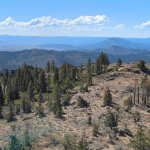By Brian K Sullivan | Bloomberg
California’s summer started with the sweet aroma of flowers, but it’s threatening to end with the acrid smell of smoke.
After two rainy winters, California’s mountains and hillsides abound with plant life — an ominous sign as the peak wildfire months approach. As soaring temperatures dry out the greenery, it becomes fuel for blazes. Excessive heat warnings stretch the length of the most populous US state this week, with Sacramento poised to hit 112F (44C) on Wednesday.
While last year’s rains mostly benefited native vegetation after a long stretch of drought, a second straight year of abundant precipitation has soaked the ground enough to allow invasive species to thrive too.
“They are annual plants, they germinate, they grow and then they die before summer,” said Denise Knapp, conservation and research director at the Santa Barbara Botanic Garden. “And there is all that biomass – fine, dry fuel – just ready to catch fire and spread fire.”
Gripped by drought since the early 2000s, California has been devastated by wildfires in recent years. They’ve caused hundreds of deaths, destroyed thousands of homes and pushed a major utility into bankruptcy after its equipment was blamed for starting a blaze. The fires are among the catastrophic extremes on every continent triggered by a rapidly changing climate.
In the last two years, California has received plenty of snow and rain during its wet season between October and April, ending years of drought and allowing plants to flourish. Last year, so-called superblooms of native flowers covered the landscape. While the colors weren’t quite so intense in 2024, there has been even more growth as invasive species start to catch up.
“We have had two excellent years of growth. This year was even better because of the way the precipitation came, which was more conducive to vegetation being able to absorb it and use it,” said Laurie Wayburn, co-founder of the Pacific Forest Trust, a non-profit conservation organization.
Related Articles
Intense Bay Area heat to crank up even more, and it may last longer than anticipated
State Farm seeks ‘massive’ insurance rate hike for California homeowners
$20 billion for climate change and school construction bonds heading toward November ballot
Spare the Air Alert issued for Tuesday as Bay Area temperatures go up
Sierra fire in Fontana grows to 400 acres, no longer threatening homes
The growth in invasive plants is elevating the threat of a severe wildfire season. Native grasses tend to handle the climate better and remain alive during the summer, while the invasive ones dry out and die, turning them into fuel, Knapp said. These non-native plants crowd out native species and form a carpet, which turns into a bed of fire when they ignite.
Whether the vegetation leads to more wildfires depends on whether extreme heat is sustained enough to dry out California’s landscape. Already, scorching weather and gusty winds are raising the risk of blazes heading into the July 4 holiday, prompting the state’s largest utility to warn it may have to shut off power lines.
Since January, 2,829 fires in California have burned 131,484 acres, according to the California Department of Forestry and Fire Protection, known as Cal Fire. That compares with an average of 3,152 fires and 27,160 acres in recent years. Daniel Swain, a climate scientist at the University of California Los Angeles, said in June that while the fire season may start out slowly, the lull won’t last.
There will probably be “a rather rapid transition to above average wildfire activity across most of the West, including California,” he said.
More stories like this are available on bloomberg.com
©2024 Bloomberg L.P.


